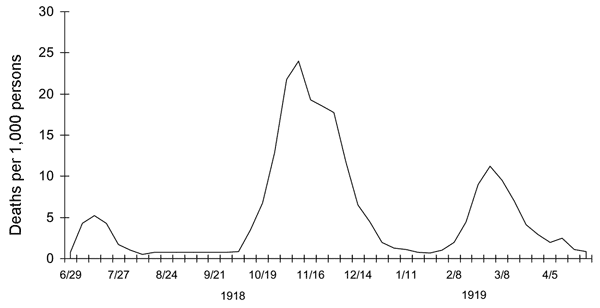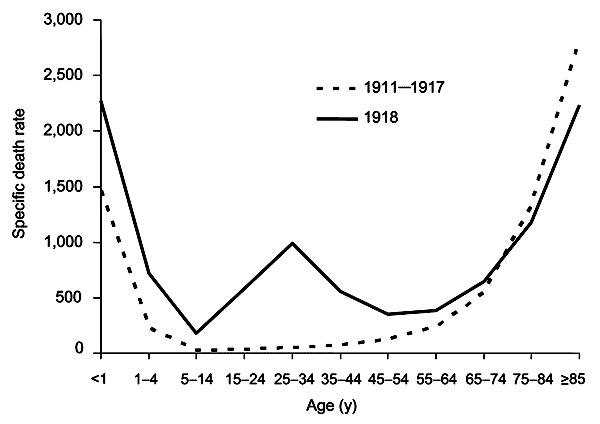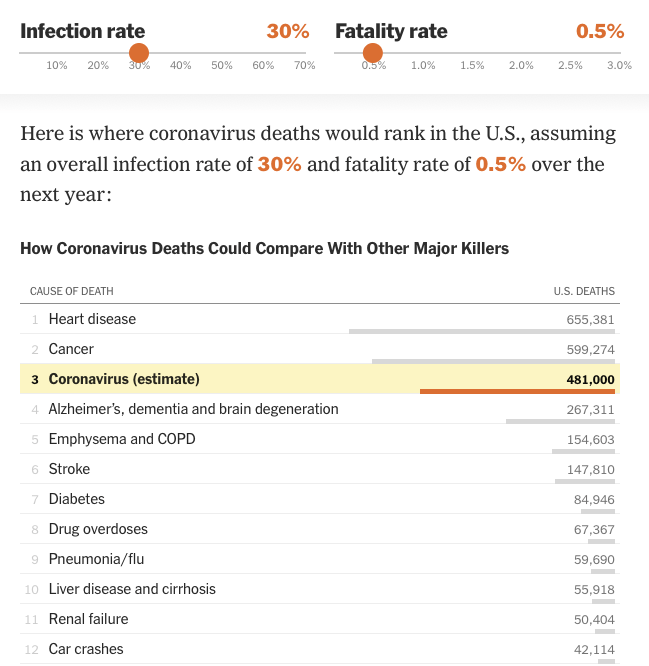You might have heard mention of the Spanish Flu epidemic of 1918 to 1919. Being the great-grandson of a doctor who came out of retirement to assist with St. Louis’s response to that epidemic, I thought I’d should share a little information about the differences and similarities between the Spanish Flu and coronavirus. I’ll briefly cover both the diseases and the responses.
Note: The word “pandemic” was unknown in 1918, so contemporaneous references to the disease used the term “epidemic.” In respect to the people of the time, I will use “epidemic” when referring specifically to the Spanish Flu and “pandemic” when referring to coronavirus or both.
Difference in Pandemics #
To understand the differences between these two pandemics, we have to consider the cultural and medical situations of the times in addition to the viruses themselves.
- Spanish Flu was a mutation of the familiar H1N1 influenza strain, while coronavirus is a coronavirus similar to SARS and some common cold strains.
- Spanish Flu’s origin is uncertain (China, Kansas, and France are all considered potential ground-zeroes.) Ground zero for coronavirus is Wuhan, China.
- Spanish Flu spread mostly through coughing, sneezing, and touching in close contact, while experts believe coronavirus spreads mostly through contact with infected surfaces as coronavirus can live for 3 days on stainless steel, plastic, and other hard surfaces.
- Spanish Flu came in three distinct waves: April-June 1918, October 1918-December 1919, and February-March 1919. coronavirus is still in its initial, and possibly only, wave.

- Spanish Flu’s second and third waves affected young adults in addition to the very young and very old, while, so far, coronavirus seems affect mostly the elderly and those with significant health issues (heart or lung disease, immune deficiencies, diabetes).

- Spanish Flu killed between 50 million and 100 million people around the world, while coronavirus has killed fewer than 10,000 so far.
- Spanish Flu’s cultural effect was muted because World War I was capturing most of the world’s attention, while coronavirus has no other major news story to compete with.
- Spanish Flu epidemic occurred before the world had vaccines against viruses or anti-viral medicines, while coronavirus is emerging in a world with many weapons to fight viral diseases.
- Spanish Flu occurred during World War I while many countries were adapted to wartime restrictions, while coronavirus struck during an economic and cultural peak in which people in developed countries enjoyed maximum freedom, high disposable income, and almost limitless sources of amusement.
- Spanish Flu epidemic ended in about April 1919 and has been carefully studied for a century. Coronavirus pandemic is just beginning, and very little is known about its trajectory and final death toll.
Similarities in Pandemics #
Again, I’ll refer to Spanish Flu as “epidemic” and coronavirus and the combined outbreaks as “pandemic.”
- Both diseases began late in the typical northern hemisphere flu season, especially in Europe and North America.
- Both diseases attacked a world human population that lacked any immunities to the disease, making every living person a potential target.
- Both diseases were met at first by a casual attitude from governments, health experts, and, especially, the public.
- Both diseases quickly spread to every continent.
- Both diseases hopped from place to place through human movement. In 1918, troops moving within and between countries as part of the war effort are considered the primary carriers; in 2020, private citizens traveling the world for vacations, business, or education seem to be the carriers.
- Both diseases kill primarily by overwhelming healthcare systems in specific locations. The Spanish Flu was especially damaging to military medical facilities, while coronavirus is affecting civilian hospitals, particularly in Wuhan, China, Northern Italy, and Iran (so far).
- Both diseases drove governments at all levels to impose restrictions of commerce and activity. St. Louis, Missouri, helped demonstrate to the world the most effective measures to combat the disease as explained in this Post-Dispatch story.
- Attempts to curtail damage from both diseases created economic hardships for business.
- Many citizens of 1918 and 2020 consider the cure worse than the disease.
2019-2020 Influenza vs. coronavirus: The Skeptics #
Many coronavirus skeptics are publishing statistical comparisons of the current flu season with the coronavirus season. This is a reasonable approach, but most of the analyses are invalid. They lack the necessary controls.
By “controls” I mean a reasonable attempt to compare likes. Let me explain.
The 2019-2020 flu season started in the US in about October, but coronavirus didn’t reach the US until February. Therefore, we have to ignore those flu numbers from October through January, since flu had a chance to infect and kill people while coronavirus did not. Most of the analyses fail to control for this factor.
Next, the flu virus was very mild in October, as it is most seasons. It takes time to spread around the country. In other words, by February when coronavirus hit the US in only a handful of locations, the flu was already widely spread. Therefore, we need to control for distribution. We can do this by factoring on known cases.
Yes, factoring out the time and distribution numbers means we throw out a lot of flu cases, but it’s the only honest way to fairly compare the two.
Third, as the skeptics rightly point out, WHO and CDC usually report flu based on estimated cases rather than confirmed cases while using confirmed cases of coronavirus. This is another number that needs to be controlled. Because we cannot estimate the number of infections of a disease that has no history, we have throw out the estimated flu cases and use only confirmed cases for analysis. When we do this, the mortality rate for flu skyrockets to 10 percent. (We know that most people with the flu never get tested, so there’s no need to panic.)
To summarize, a meaningful comparison of flu and coronavirus mortality must:
- Control for the time in which the disease has been present a population.
- Control for spread of the disease within a population.
- Control for confirmed vs. estimated cases.
I’m not going to do the analysis with proper controls. I don’t have time, and I am not confident I can get raw data that’s equally valid for both diseases. But I ask anyone doing such analysis to carefully control what they’re comparing. Otherwise, they will create a false sense of security or false sense of panic, depending on which controls they leave out or which narrative they’re trying to push.
I did find that, according to the CDC, there were 364 deaths due to influenza in the United States in the first week of March (link), and there have been 150 deaths from coronavirus in the month of March. If I could find the number of confirmed cases of each for the same week, I could provide a somewhat realistic comparison between the two.
If someone would like to produce such an analysis, I’d be happy to publish it here.
Finally, some skeptics are pointing out the mortality rate for coronavirus in the United States is “only” 1.4 percent of confirmed cases. That sounds low compared to influenza, which has a 10 percent mortality rate in confirmed cases. But these skeptics need to consider that about 60 percent of Americans are immune to this season’s predominant flu bug, while 0 percent of us are immune to coronavirus. If we look back at the morbidity (infection) rate of Spanish Flu, we learn that about 30 percent of Americans caught the disease. So we must ask: if 30 percent of Americans come down with coronavirus, how many will die? And, just to be extra optimistic, let’s assume tiny mortality rate of just 0.5 percent.
The answer: 481,000 deaths. That’s more than 10 times the number of deaths caused by car accidents.

The point here is that coronavirus has the potential to infect many more people than the flu. Therefore, even if it’s far less lethal in terms of mortality rate, it could kill far more people.
I know these skeptics don’t mean to make light of the situation. They (justifiably) don’t trust globalist organizations like the WHO. If they read this post, they’ll agree that we need to stop the virus. Besides, I was a skeptic until about a week ago.
The Second (and Third) Waves #
The Spanish Flu epidemic seemed over in June 1918. Up to that point, the Spanish Flu looked a run-of-the-mill virus, affecting mostly infants and the elderly.
But that flu wasn’t gone; it was hiding and mutating.
In October, the epidemic we now call Spanish Flu truly emerged. Not only did millions become infected, the disease attacked young adults almost as dramatically as it did babies and old people.
Look, again, at the time chart.

And the age chart:

My great-grandfather, Dr. William T. Mahon, was a country doctor from Chamois, Missouri who retired to St. Louis (Benton Park) in about 1909.

— Dr. W. T. Mahon and wife Georgie, circa 1930
My uncle Pat (or my aunt Mary Jane) showed me some of his notes and journals when I was a kid. I remember his notes about the flu epidemic in 1918. Uncle Pat told me his grandfather helped out as he could. The problem was that doctors and nurses were getting sick, as were patients who were going to the hospital for problems unrelated to the flu.
(Read this 1889 article about my great-grandfather Dr. William T. Mahon)
Pat also remembered that everything had to be “locked down” to keep the flu from spreading.
This memory, triggered, I’m sure, by references to the Spanish Flu in recent days, led me to do a little research into that historical epidemic. That led me to shift my view of coronavirus from skeptic to advocate for a fairly massive mitigation mission. Driving that shift was this paragraph from the Post-Dispatch story I linked earlier:
In early October, city health commissioner Dr. Max C. Starkloff ordered the closure of schools, movie theaters, saloons, sporting events and other public gathering spots. Churches were told to suspend Sunday services. At the time, with nearly 800,000 residents, St. Louis was among the top 10 largest American cities.
(Note: Some of the facts presented in the Post-Dispatch story contradict academic research into the Spanish Flu epidemic. This is likely the result of the Post writer relying on old articles from the paper. These facts might have been generally accepted at the time those old stories were written, but further research has revealed more accurate information or called into question prior assumptions.)
St. Louis, thanks to Dr. Starkloff’s “overreaction,” suffered far fewer deaths to Spanish Flu than other cities of similar size that waited to enact behavior restrictions.
I also learned that the 1918-1919 flu mutated over the summer. I remember from biology class that the more an organism reproduces, the more mutation is possible. Thus, the more people infected, the greater potential that coronavirus could morph into an even deadlier disease. And no one wants a second wave of this menace just as kids go back to school in the fall.
Finally, I’m not scared or panicked about coronavirus. At all. I am concerned about the economy. I worry that some people will overreact in a bad way. But I’m no more concerned about catching this disease than I am about catching the flu or a bad cold. I don’t like to be sick. My support for aggressive prevention stems from the fact that this is a new disease. Everyone on earth is susceptible, and if everyone on earth catches the disease, millions will die from it, even if the mortality rate is only 0.5 percent. That’s millions of deaths over and above the deaths that will happen as a result of legacy diseases and accidents. I’d rather we stop that early and get back to normality. Therefore, I think President Trump is doing a magnificent job. Magnificent.
And, so we don’t forget, God made us and the virus. Even if prayers don’t obliterate the virus, they will strengthen us. And maybe that’s why the virus is upon us in the first place.
God bless.

